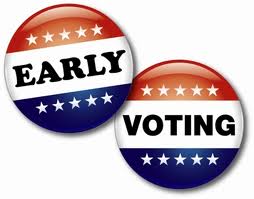Here’s the Chron story about how early voting went.
“Each (side) is emphasizing areas of comparative advantage, but the overall pattern seems to be unimpressive in terms of overall turnout,” said Jim Henson, who directs the Texas Politics Project at the University of Texas at Austin. “I don’t see anything in the voting numbers as we have them so far to suggest a disruption in the normal pattern.”
Based on numbers kept by the secretary of state’s office, nearly 1.5 million people had voted early through Thursday in Texas’ 15 biggest counties, barely topping the same number at this point in 2010. The early voting turnout rate was down more than 7 percent.
“The numbers for early voting in this 2014 election cycle are comparable to what we saw in 2010,” said Alicia Pierce, a spokeswoman for the office, echoing not only Republicans but also independent experts who have been crunching the numbers on their own.
Polling stations in Harris County experienced a surge on Friday, the last day to cast a ballot in-person before Election Day on Nov. 4. Workers processed 51,628 voters – the highest daily number of the early-voting period.
But overall, early turnout in Harris County dropped 16 percent compared to the midterm count four years ago, from 444,648 to 375,247 this cycle.
In-person voters numbered 307,280 for the dozen days of early voting, compared to the final early number in 2010 – 392,536.
Still, more mail-in ballots were returned this cycle, 67,967 compared to 52,112 in 2010, which may suggest that efforts to get more people to vote using that method worked.
Harris County Clerk Stan Stanart said he expects a non-record-breaking turnout of about 300,000 voters on Tuesday. “Voters, they do their own thing,” he said, adding that state and national moods appear to influence turnouts.
The analysis of Friday’s batch of votes was that it was a good day for the Democrats, which brought the projected Dem share of the overall early vote in Harris County to 46.7%. That happens to be a very conducive number for some back-of-the-envelope math. With turnout so far at 375K, this puts Democrats down about 25K votes, 200K to 175K. That’s without taking into account the Greens and Libs, the extra mail ballots that will arrive by Tuesday, and undervotes, but it’s close enough for these purposes. If we accept Stan Stanart’s guess of 300K turnout for Tuesday, that means Dems need a win of 162,500 to 137,500 for a 50-50 county. That’s roughly a 54.2-45.8 spread for the Ds, or an improvement of 7.5 points over EV. In 2010, Dems improved by about 7 points from EV to E-Day (39% to 46%). So it’s doable, though obviously a bit of a stretch.
One thing to note from this is that if this projection is accurate, Dem turnout in Harris County will be up a smidge from 2010 – could be a slightly larger smidge if the projection underestimates the Dems, or it could be that there is no smidge if it’s an overestimate – while Republican turnout is down considerably. That shouldn’t be a big surprise – 2010 was fueled by a huge wave of previously Presidential-year-only Republican voters. I’ve said all along that while we ought to expect some of them to show up this year, it’s unlikely they all would. It stands to reason that a lack of these surge voters would have an effect. I suspect that this pattern will hold around the state, with perhaps some local variations here and there, like in Bexar County, but I have no data to verify this. What this means for final state totals remains to be seen. Let’s assume that the Rs have something like 2002 turnout, which is to say between 2.7 million and 2.8 million. If Dems can reach or edge past the Bill White line – say 2.1 or 2.2 million – that puts them at 43 or 44 percent, more or less. If that’s true for the whole ticket and not just one Bill White-like candidate, I’d count that as solid progress, if perhaps a bit short of my fonder hopes. It would also still be a double-digit loss, likely between 12 and 14 points. You can close a lot of the gap from 2010 and still have a lot more gap left to close. If however we’re looking at no more than an “up a smidge” situation statewide, so that Dems are still in the 1.8 million range, we’re looking at a 20-point loss. I’d be hard pressed to find anything positive about that regardless of what else might have happened.
None of this should be taken as gospel. I’m extrapolating from a limited data set. It would have been awesome to have seen some clear evidence of a Democratic surge, but I don’t. There is room to make up ground on Election Day, though, so keep at it till the final bell rings. Remember also that when BGTX first arrived, back when no Democrats were running for Governor, they were talking about a multi-year process, with a target date of 2020. Whatever does happen, we have to build on it. Move forward or get left behind.
Finally, a small point of disagreement with my friend PDiddie. If Susan Criss holds HD23, I see no way the Dems lose any seats in the Lege. The most likely outcomes range from -1 to +3 for the Dems, depending on HD23, those two Dallas districts, and HD43. There are Dem incumbents that would have to sweat it out in a year more like 2010, but there’s no evidence to suggest we have that kind of year.

